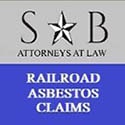
Railroad workers have long been exposed to asbestos, a harmful material once widely used for its insulating properties. If you worked on the railroads prior to 1982, you might have been exposed to asbestos, which can lead to serious health issues, including mesothelioma and lung cancer. The legacy of asbestos in the railroad industry is a grim reminder of how industrial advancements sometimes come at a severe human cost. This article will address some of the top questions about railroad asbestos claims, providing you with the information you need to understand your rights and options. Understanding these claims is crucial for anyone potentially affected, as it opens avenues for justice and compensation.
Asbestos is a group of naturally occurring minerals known for their heat resistance and insulating properties. It was widely used in various industries, including railroads, for decades. The material’s fibrous nature allows it to be woven into fabrics and mixed with other materials, enhancing its versatility and utility in industrial applications. In the railroad industry, asbestos was used in brake pads, insulation for pipes and boilers, gaskets, and other components. Its durability and resistance to heat made it a popular choice, despite its dangerous health implications. Unfortunately, the very properties that made asbestos desirable also contributed to its hazardous nature, as tiny fibers can easily become airborne and inhaled.
The historical use of asbestos in railroads underscores a time when industrial safety standards were not as rigorous or enforced as today. Manufacturers and companies prioritized performance and cost-efficiency over health considerations, often ignoring early warnings about asbestos risks. This oversight has resulted in long-term health repercussions for workers and their families, illustrating the need for stringent safety regulations in industries handling hazardous materials.
How Does Asbestos Exposure Occur?
Asbestos exposure occurs when asbestos fibers are disturbed and become airborne. Workers who directly handled asbestos-containing materials, such as mechanics, engineers, and construction crews, were at the greatest risk. The danger lies in the microscopic fibers that, when inhaled, can lodge themselves in lung tissue, leading to severe health complications over time. However, exposure wasn’t limited to those directly handling the materials; fibers could also be inhaled by anyone working nearby or even brought home on clothing, affecting family members. This secondary exposure has been a silent threat, often overlooked in the initial safety assessments, yet it poses a significant risk to unwitting individuals.
The pervasive nature of asbestos exposure highlights the importance of safety protocols and protective equipment in mitigating risk. Despite advancements in safety, the latency period of asbestos-related diseases means that individuals exposed decades ago are only now experiencing the health consequences. This delayed onset of symptoms complicates diagnosis and treatment, making awareness and early detection crucial.
What Health Issues Are Associated with Asbestos Exposure?
Asbestos exposure is a serious health risk. Inhaled fibers can become trapped in the lungs, leading to several diseases, including:
- Asbestosis: A chronic lung disease causing scarring of lung tissue. The condition can severely impair lung function, leading to breathing difficulties and reduced quality of life.
- Mesothelioma: A rare cancer affecting the lining of the lungs, chest cavity, or abdomen. This aggressive cancer has a poor prognosis, with limited treatment options once diagnosed.
- Lung Cancer: Asbestos exposure significantly increases the risk of lung cancer, compounding the effects of other risk factors such as smoking.
Symptoms of these diseases might not appear until decades after exposure, making early detection and diagnosis challenging. This latency period can span 20-50 years, often leading to diagnoses when the disease is in advanced stages. The insidious nature of asbestos-related diseases underscores the importance of regular medical check-ups for individuals with known exposure and highlights the need for continuous research into better diagnostic and treatment methods.
Who Can File a Railroad Asbestos Claim?
If you worked on the railroads before 1982 and have been diagnosed with an asbestos-related disease, you might be eligible to file a claim. Additionally, family members who have suffered due to secondary exposure (from fibers brought home on clothing, for example) may also be eligible. The eligibility criteria can vary based on the specific circumstances of exposure and the jurisdiction in which the claim is filed. It’s essential to consult with a legal expert to understand your eligibility and the specifics of your situation. They can provide guidance on the nuances of the law and help determine the best course of action.
The process of filing a claim can be daunting, especially for individuals already dealing with health issues. Legal experts specializing in asbestos claims can offer invaluable support, ensuring that all necessary documentation is in order and that the claim is filed within the appropriate time frame. Their experience can be a critical asset in navigating the legal complexities and advocating effectively for your rights.
What Is the Process for Filing a Railroad Asbestos Claim?
The process begins with a thorough review of your work history and medical records. Here’s a general outline of the steps involved:
- Consultation with a Lawyer: Reach out to a law firm experienced in asbestos claims, like Sammons & Berry. They can help determine your eligibility and guide you through the process. An initial consultation can provide clarity on potential outcomes and the strength of your case.
- Gathering Evidence: Collect medical records, employment history, and any other documentation supporting your exposure and diagnosis. Evidence can include witness statements, employment records, and expert medical opinions.
- Filing the Claim: Your lawyer will file a claim on your behalf, which may involve negotiations or litigation. The legal process can be lengthy, requiring patience and perseverance as your case progresses.
- Settlement or Verdict: Many asbestos claims are settled out of court, but some may go to trial. Your lawyer will advise you on the best course of action. Settlements can provide quicker resolution, whereas trials might offer higher compensation but come with greater uncertainty.
The legal journey can be complex, with various procedural and substantive hurdles to overcome. A dedicated legal team can manage these challenges, ensuring that your claim is presented compellingly and persuasively to secure the best possible outcome.
Why Choose Sammons & Berry Law Firm for Your Claim?
Sammons & Berry has extensive experience handling railroad asbestos claims. They understand the complexities of these cases and are committed to helping victims and their families seek justice. Their expertise can be invaluable in navigating the legal process and ensuring you receive the compensation you deserve. The firm’s track record demonstrates a deep commitment to client advocacy, providing personalized attention to each case.
Choosing the right law firm can significantly influence the outcome of your claim. Sammons & Berry offers a client-centered approach, prioritizing open communication and transparency throughout the legal process. Their strategic insights and thorough understanding of asbestos litigation can help build a robust case, maximizing your chances of a favorable resolution.
How Long Do I Have to File a Claim?
Statutes of limitations vary by state, which means there is a limited time frame to file a claim after a diagnosis. Each jurisdiction sets its deadlines, typically ranging from one to several years post-diagnosis, emphasizing the need for prompt legal action. It’s crucial to act quickly to ensure your rights are protected. Consulting with a knowledgeable attorney as soon as possible can help you understand the timeline and prevent missing critical deadlines. Attorneys can also advise on any exceptions or extensions that may apply to your specific situation.
Missing the deadline can forfeit your right to seek compensation, underscoring the importance of timely legal consultation. Early engagement with an attorney can also facilitate a more thorough preparation of your case, allowing ample time to gather evidence and build a compelling argument for your claim.
What Compensation Can I Expect from a Railroad Asbestos Claim?
Compensation from asbestos claims can cover various damages, including:
- Medical Expenses: Costs of treatment, medication, and ongoing care. This includes both past and future medical costs associated with managing the disease.
- Lost Wages: Compensation for time you were unable to work due to illness. This can also cover reduced earning capacity if the illness impacts your ability to work in the future.
- Pain and Suffering: Damages for physical and emotional distress caused by the disease. This aspect of compensation acknowledges the profound impact on your quality of life.
- Loss of Consortium: Compensation for the impact on family relationships. This recognizes the strain that asbestos-related illnesses can place on personal and familial bonds.
The amount of compensation varies based on the specifics of each case, including the severity of the illness and the degree of negligence involved. Each case is unique, and experienced legal counsel can provide an estimate based on precedent and the particulars of your situation.
What Are the Challenges in Proving a Railroad Asbestos Claim?
Proving an asbestos claim can be complex due to the time elapsed since exposure and the need for detailed documentation. Challenges include:
- Proving Exposure: Demonstrating that you were exposed to asbestos at work. This often requires employment records, testimonies from co-workers, and expert analysis.
- Linking Exposure to Illness: Establishing a connection between the exposure and your diagnosis. Medical expert testimony is often crucial in substantiating this link.
- Employer Liability: Showing that the employer was negligent in protecting workers. This involves proving that the employer knew or should have known about the asbestos risks and failed to act appropriately.
These challenges highlight the importance of working with an experienced law firm that can effectively gather evidence and build a strong case. Legal expertise can be critical in overcoming these hurdles, ensuring that your claim is robust and well-supported.
What Should I Do If I Suspect Asbestos Exposure?
If you suspect you were exposed to asbestos, take immediate action:
- Seek Medical Attention: Early detection is critical. Inform your doctor about your exposure history. Regular check-ups and screenings can help catch potential issues before they develop into severe health problems.
- Consult a Legal Expert: Contact a law firm specializing in asbestos claims to explore your legal options. A legal expert can provide guidance on your rights and potential avenues for compensation.
- Document Everything: Keep detailed records of your work history, medical visits, and any symptoms you experience. Comprehensive documentation can strengthen your claim and provide a clear timeline of your exposure and health developments.
Early intervention can significantly influence health outcomes and legal success. Being proactive about your health and legal rights is essential in navigating the aftermath of asbestos exposure.
Experienced Professionals
Railroad asbestos claims are a vital avenue for workers and their families to seek justice and compensation for asbestos-related diseases. Understanding the process, your rights, and the potential challenges can help you make informed decisions. Navigating this complex legal landscape requires diligence and the support of experienced professionals. If you believe you have a claim, don’t hesitate to reach out to experienced professionals who can guide you through this complex legal journey. They can provide the support and expertise needed to pursue justice effectively.
For more information, visit https://railroadasbestosclaims.com/qualify/.
See if you qualify for compensation
Sammons & Berry, P.C.
800-519-1440
View our Google Listing


